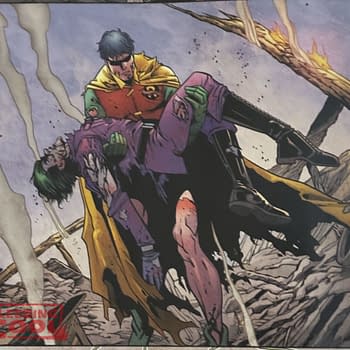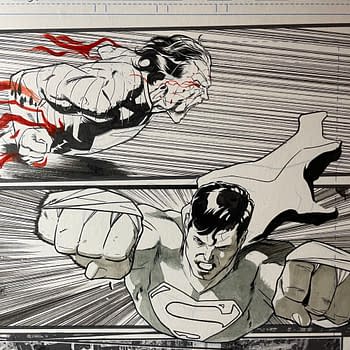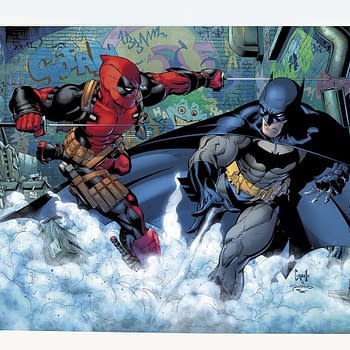Posted in: Comics, Recent Updates | Tagged: By the Silver Waters of Lake Champlain, Charles Paul Wilson III, Comics, entertainment, harlan ellison, horror, idw, Jason Ciaramella, Jeremy Mohler, joe hill, neil gaiman, Robbie Robbins, science fiction, Shadow Show
Shadow Show From IDW Is One Of Those Projects That Should Happen And Did

Hopefully, one of the first things that occurred to comics readers when they saw the collection was that it would make an excellent adaptation to the comics medium, but the reason for that is perhaps one degree removed from the obvious: not only do Bradbury's ideas usually make for great visual adaptation, but translating them into a new form in the comics medium gives comic artists, as opposed to just writers, the chance to make their own visual statement about the role Ray Bradbury has played in the development of their own work and imaginations. With cross-media writers like Joe Hill, Neil Gaiman, and Harlan Ellison contributing stories to the original volume of prose, it's only fair that comic artists get a chance to make that statement too, in their own way.
The first issue of Shadow Show from IDW arrives today in shops, featuring the work of Joe Hill, Charles Paul Wilson III, Jason Ciaramella, Jeremy Mohler and Robbie Robbins. Ciaramella has handled the adaptation of Hill's original prose into comics format (as he did with The Cape), and the team-up with Wilson III is so highly appropriate that fans of Hill and Wilson III's work together on Wraith, also from IDW, will be well pleased to see them in combination here. The story, "By the Silver Waters of Lake Champlain" is an excellent choice to start out this comic series and sets the tone for future issues. It deals with subtle twists in reality, danger, and presents a generally challenging view to "normal" existence in the way that speculative fiction should, which really means, of course, that it has Ray Bradbury written all over it.
The tension at work in the story itself is between the vast reaches of the imagination, here depicted in the minds of children, and the equally vast currents of tendencies in the natural and physical world, including society. And when those two equally cataclysmic forces meet, the outcome is far from certain. Hill and Ciaramella are presenting a story that seems overloaded with the wild energy of children, their blind impetus toward action and hope, surrounded by the more somber tones of adult realities. What Charles Paul Wilson III does so remarkably is light the fuse on those combustible elements and make the reader feel absolutely surrounded by that explosion of energy in childhood, complete with the darker possibilities of that energy, as well filling out those somber adult notes with an atmosphere of world-weary domesticity in home-life scenes.
Wilson III also takes particular artistic flight when he's given the chance to do a full page spread where our two child protagonists imagine a future of wealth and achieved dreams for themselves in a flurry of realization at the potential money and fame may bring to them. Though it's an imaginative scene, it's as jam-packed with action and intensity as previous panels overrun by loud and physically combative children. All the artwork in the story, in fact, contains the same degree of fever pitch and tension, while it also strikes the briefly quieter, poignant notes that will contribute to its conclusion.
The overriding and interesting, lingering contrast the story seems to make lies between things that can happen, and things that are "never going to happen" in life. The outrageously clever aspect of this contrast is that seeing and believing that a sea-monster might actually exist is not, in fact, the "never going to happen" aspect of the story, and it almost becomes a side-note in the bigger question about our hopes and dreams. It's a credit to the whole creative team that they constructed a story so intense, colorful, and engaging that you can breeze right past something that would otherwise be shocking in favor of following the emotional lives of the characters as the central drama of the tale.
It's a strong first outing for Shadow Show, and you should certainly look forward to next month's Issue #2 which will contain Neil Gaiman's "The Man Who Forgot Ray Bradbury," with artist Maria Fröhlich, and Audrey Niffenegger's "Backward In Seville" drawn by the great Eddie Campbell. Shadow Show will be a 5 issue series, and assuming it will be a collection, too, that's going to be one to clear room on the shelf for.
*Coincidentally, Bleeding Cool Magazine #13, the Power List issue, out today, also contains an excellent editorial by our own columnist Jared Cornelius of Typing on the Dead and Sweet Release! on Ray Bradbury's life, career, and impact as seen through Shadow Show, so keep an eye out for that, too.
Hannah Means-Shannon is EIC at Bleeding Cool and @hannahmenzies on Twitter


















